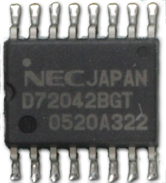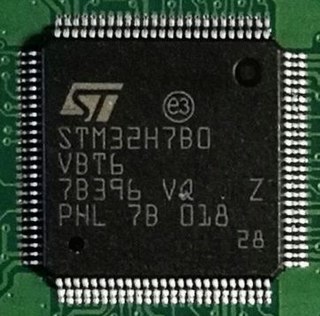
A microcontroller or microcontroller unit (MCU) is a small computer on a single integrated circuit. A microcontroller contains one or more CPUs along with memory and programmable input/output peripherals. Program memory in the form of NOR flash, OTP ROM, or ferroelectric RAM is also often included on the chip, as well as a small amount of RAM. Microcontrollers are designed for embedded applications, in contrast to the microprocessors used in personal computers or other general-purpose applications consisting of various discrete chips.

The Intel MCS-51 is a single chip microcontroller (MCU) series developed by Intel in 1980 for use in embedded systems. The architect of the Intel MCS-51 instruction set was John H. Wharton. Intel's original versions were popular in the 1980s and early 1990s, and enhanced binary compatible derivatives remain popular today. It is a complex instruction set computer with separate memory spaces for program instructions and data.
SuperH is a 32-bit reduced instruction set computing (RISC) instruction set architecture (ISA) developed by Hitachi and currently produced by Renesas. It is implemented by microcontrollers and microprocessors for embedded systems.

PIC is a family of microcontrollers made by Microchip Technology, derived from the PIC1640 originally developed by General Instrument's Microelectronics Division. The name PIC initially referred to Peripheral Interface Controller, and is currently expanded as Programmable Intelligent Computer. The first parts of the family were available in 1976; by 2013 the company had shipped more than twelve billion individual parts, used in a wide variety of embedded systems.

The MSP430 is a mixed-signal microcontroller family from Texas Instruments, first introduced on 14 February 1992. Built around a 16-bit CPU, the MSP430 was designed for low power consumption, embedded applications and low cost.
Memory-mapped I/O (MMIO) and port-mapped I/O (PMIO) are two complementary methods of performing input/output (I/O) between the central processing unit (CPU) and peripheral devices in a computer. An alternative approach is using dedicated I/O processors, commonly known as channels on mainframe computers, which execute their own instructions.
Renesas Electronics Corporation is a Japanese semiconductor manufacturer headquartered in Tokyo, Japan, initially incorporated in 2002 as Renesas Technology, the consolidated entity of the semiconductor units of Hitachi and Mitsubishi excluding their dynamic random-access memory (DRAM) businesses, to which NEC Electronics merged in 2010, resulting in a minor change in the corporate name and logo to as it is now.
4-bit computing is the use of computer architectures in which integers and other data units are 4 bits wide. 4-bit central processing unit (CPU) and arithmetic logic unit (ALU) architectures are those that are based on registers or data buses of that size. A group of four bits is also called a nibble and has 24 = 16 possible values, with a range of 0 to 15.

The M6800 Microcomputer System was a series of 8-bit microprocessors and microcontrollers from Motorola that began with the 6800 CPU. The architecture also inspired the MOS Technology 6502, and that company started in the microprocessor business producing 6800 replacements.

The Zilog Z8 is a microcontroller architecture, originally introduced by Zilog in 1979. Today the line also includes the Z8 Encore!, eZ8 Encore!, eZ8 Encore! XP, and eZ8 Encore! MC families.

V850 is a 32-bit RISC CPU architecture produced by Renesas Electronics for embedded microcontrollers. It was designed by NEC as a replacement for their earlier NEC V60 family, and was introduced shortly before NEC sold their designs to Renesas in the early 1990s. It has continued to be developed by Renesas as of 2018.

IEBus is a communication bus specification "between equipments within a vehicle or a chassis" of Renesas Electronics. It defines OSI model layer 1 and layer 2 specification. IEBus is mainly used for car audio and car navigations, which established de facto standard in Japan, though SAE J1850 is major in United States.
IEBus is also used in some vending machines, which major customer is Fuji Electric. Each button on the vending machine has an IEBus ID, i.e. has a controller.
Detailed specification is disclosed to licensees only, but protocol analyzers are provided from some test equipment vendors. Its modulation method is PWM with 6.00 MHz base clock originally, but most of automotive customers use 6.291 MHz, and physical layer is a pair of differential signalling harness. Its physical layer adopts half-duplex, asynchronous, and multi-master communication with carrier-sense multiple access with collision detection (CSMA/CD) for medium access control. It allows for up to fifty units on one bus over a maximum length of 150 meters. Two differential signalling lines are used with Bus+ / Bus− naming, sometimes labeled as Data(+) / Data(−).
The Mitsubishi 740, also known as MELPS 740, is a series of 8-bit CMOS microcontrollers and microprocessors with an enhanced MOS Technology 6502 compatible core based on the expanded WDC 65C02. The ICs were manufactured by Mitsubishi Electric during the 1980s and 1990s.

The ARM Cortex-M is a group of 32-bit RISC ARM processor cores licensed by ARM Limited. These cores are optimized for low-cost and energy-efficient integrated circuits, which have been embedded in tens of billions of consumer devices. Though they are most often the main component of microcontroller chips, sometimes they are embedded inside other types of chips too. The Cortex-M family consists of Cortex-M0, Cortex-M0+, Cortex-M1, Cortex-M3, Cortex-M4, Cortex-M7, Cortex-M23, Cortex-M33, Cortex-M35P, Cortex-M52, Cortex-M55, Cortex-M85. A floating-point unit (FPU) option is available for Cortex-M4 / M7 / M33 / M35P / M52 / M55 / M85 cores, and when included in the silicon these cores are sometimes known as "Cortex-MxF", where 'x' is the core variant.

STM32 is a family of 32-bit microcontroller integrated circuits by STMicroelectronics. The STM32 chips are grouped into related series that are based around the same 32-bit ARM processor core: Cortex-M0, Cortex-M0+, Cortex-M3, Cortex-M4, Cortex-M7, Cortex-M33. Internally, each microcontroller consists of ARM processor core(s), flash memory, static RAM, debugging interface, and various peripherals.

LPC is a family of 32-bit microcontroller integrated circuits by NXP Semiconductors. The LPC chips are grouped into related series that are based around the same 32-bit ARM processor core, such as the Cortex-M4F, Cortex-M3, Cortex-M0+, or Cortex-M0. Internally, each microcontroller consists of the processor core, static RAM memory, flash memory, debugging interface, and various peripherals. The earliest LPC series were based on the Intel 8-bit 80C51 core. As of February 2011, NXP had shipped over one billion ARM processor-based chips.
RL78 Family is a 16-bit CPU core for embedded microcontrollers of Renesas Electronics introduced in 2010.

78K is the trademark name of 16- and 8-bit microcontroller family manufactured by Renesas Electronics, originally developed by NEC started in 1986. The basis of 78K Family is an accumulator-based register-bank CISC architecture. 78K is a single-chip microcontroller, which usually integrates; program ROM, data RAM, serial interfaces, timers, I/O ports, an A/D converter, an interrupt controller, and a CPU core, on one die.














